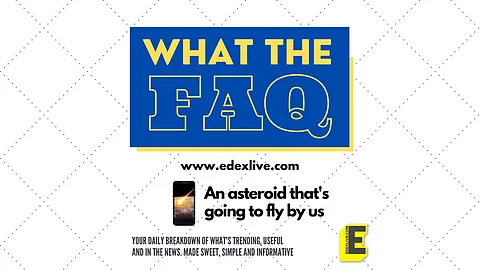

If you are awake at 3:21 am tonight, do look at the sky. Not for Batman or Superman, but to behold a huge asteroid, twice the size of Burj Khalifa, they say. Though it's going to be relatively close while shooting past Planet Earth, it's going to fly past safely and is the one to watch out for.
Should we be panicking or just be expecting a celestial event like no other? Let's find out!
First and foremost, more details about this particular asteroid, please!
Asteroid 7482, or 1994 PC1 as it is referred to, is about 1.6 km wide or more than 3,280 feet across. It is going to fly past our planet at a 19,79,493.12 km distance. It is travelling at a speed of 19.56 kilometres per second. With over a million asteroids existing in space, it is not unusual for them to pass by Earth every now and then. NASA (National Aeronautics and Space Administration) says that between Wednesday and Thursday (January 19 and 20) this week alone, about five asteroids will zoom past our planet.
Has NASA been monitoring the asteroid?
Yes, of course! Since this particular asteroid was discovered in August 1994, the space agency has been keeping an eye on it. It was classified as an Apollo asteroid and "potentially hazardous" as well. Apollo asteroids are Near Earth Asteroids (NEAs) that cross Earth's orbit and NASA says it is "potentially hazardous" for its "potential to make threatening close approaches to Earth". It was Robert McNaught at Australia's Siding Spring Observatory who discovered the asteroid.
READ ALSO : What The FAQ: What is NASA's DART Mission to crash a spacecraft in space all about?
So, it is dangerous?
NASA's Jet Propulsion Laboratory says that this particular asteroid will be the only one to pass by this close to our planet since January 17, 1933. The closest approach will be at 3:21 am IST and this will be the closest this asteroid will get for 200 years, as per the calculations of scientists. But as per the assurance given by NASA’s Planetary Defense Coordination Office via a tweet, "Rest assured, 1994 PC1 will safely fly past our planet 1.2 million miles away..."
Can we spot it from our backyards?
Over the course of the evening, the asteroid will seem like a point of light passing through the sky with a background full of stars. Amateur astronomers with six-inch or larger telescopes will be able to spot the asteroid, which will shine at a magnitude (celestial object's apparent brightness) of ten. Use references like star HIP 8210, HIP 7620, Galaxy IC 1723 and a few others.
Will the same asteroid pass Earth again?
Indeed. It is in July this year that the asteroid will pass Earth again, but at a much further distance.
Can only amateur astronomers with telescopes spot it?
You can keep a track of it via this website by NASA eyes.nasa.gov/apps/
